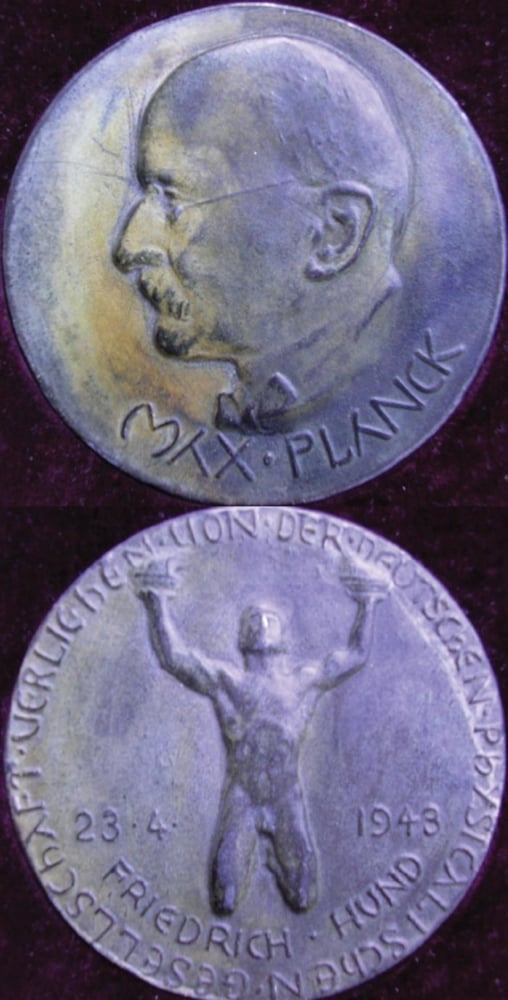The German Physical Society in the Third Reich: Physicists Between Autonomy and Accommodation
Ed. Dieter Hoffmann and Mark Walker
2012 Cambridge University Press £55.00hb 458pp

At the turn of the 20th century, German scientists led the world. Four decades later, their nation’s reputation in the field was only a husk of what it had been. The cause of this transformation was the Nazi rise to power in 1933, which went on to precipitate one of the biggest intellectual migrations in history. Many hundreds of scientists, most of them Jewish, fled Germany in the years that followed. As well as diminishing German science, their departure also shifted the focus of world science westwards across the Atlantic.
The contributions of these émigré scientists to intellectual life in their new homes (and to the Allied war effort) have been well documented (see “When physics was ‘made in the USA’ ”). The fate of the scientific community they left behind, however, is less well known in the English-speaking world. The new English translation of The German Physical Society in the Third Reich helps fill this gap. Edited by Dieter Hoffmann and Mark Walker, this dense volume contains 11 scholarly essays (including an introduction) that together provide an incisive and sometimes poignant snapshot of the German physics community during the most tempestuous period of its history. They also display vividly how science can suffer under dictatorships, and how the society’s unpredictable fortunes mirrored the tumult inside Germany.
The most famous member of the German Physical Society (DPG) and its one-time president, Albert Einstein, had presciently left Germany before the Nazis came to power, but for the rest of academia, the Third Reich truly began in April 1933, when the Law for the Restoration of the Civil Service came into effect. Under this new law, state employees of “non-Aryan – particularly Jewish” descent lost their jobs. Even those who were not directly affected had to join the party or sign up for political education. This thunderclap was soon followed by the crushing Nuremberg decrees, which relegated Jews to marginal citizenship and further accelerated the move to migrate.
In his essay “Marginalization and expulsion of physicists”, Stefan Wolff of the Deutsches Museum shows that there was little public protest at these actions. This reaction – or rather non-reaction – was mirrored by the DPG, which at this early stage was still trying to remain aloof from politics. Although the society was not initially forced to purge itself of its Jewish members (it waited until 1938 to expel them formally), many chose to leave of their own accord. The results were stark: as an illustration in the book shows, in some cases the list of editors displayed on the masthead of leading journals shrank by up to 90%. Many of the 100 or so DPG members who resigned because of racial or political discrimination emigrated, while others found niches in industrial research or simply retired. An appendix lists their names and their eventual fates; in some cases, terse statements such as “murdered in USSR” or “survived Buchenwald” invite further research.
The book contains many examples of how the Third Reich politicized science. One authoritative chapter, written by Deutsches Museum historian Michael Eckert, describes how the wretched cult of “Aryan physics” rejected the supposedly “Jewish” sciences of relativity and quantum mechanics, to the obvious detriment of the country’s scientific establishment. Among those affected was Werner Heisenberg, who was stigmatized as a “white Jew” because of his involvement in quantum mechanics. Heisenberg was long thought to be an automatic choice to succeed Arnold Sommerfeld as head of the theoretical physics school in Munich, but after tortuous deliberation by the authorities in Berlin, the position went to a less worthy figure. With such lamentable decisions, the reputation of German physics crumbled.
It was not until war had begun that DPG members, notably Wolfgang Finkelnburg, realized that their rejection of modern physics had led them to an impasse, and tried as best they could to backtrack. At the same time, the society was gradually moving towards a policy of appeasement, a process acknowledged in the book’s subtitle, “Physicists Between Autonomy and Accommodation”. By 1942 the DPG was urging the nation to mobilize its scientific abilities, particularly in the nuclear sector. But this was too little, too late, and it prompted much soul-searching post-1945 – hence the title of the final chapter, “Cleanliness among our circle of colleagues”. “Cleanliness” in this context implies intellectual objectivity rather than “name and shame” denunciation.
The Nazis deemed Nobel awards inappropriate for Aryans
The overriding impression is of a weak and ineffectual society unwilling or unable to put up much resistance against the Nazis’ unilateral decisions. Like the doyen of German physics, Max Planck, the DPG swayed in the face of them like a tree in the wind. A few individual scientists did, however, make a stand. Among them was Fritz Haber, the 1918 Nobel laureate in chemistry. Although Haber was Jewish, he was technically exempt from the Civil Service Law because of his war service (he had pioneered the use of poison gas as a weapon during the First World War) and his stature in the scientific community, and thus could have remained in his position as director of Berlin’s Kaiser Wilhelm Institute for Physical Chemistry. Instead, he resigned and left Germany.
Haber’s efforts to find a new position abroad were snubbed by those who remembered his work with chemical weapons and he died in 1934 before he could find another scientific post. The first anniversary of his death was commemorated with a memorial meeting organized by Planck, who boldly went ahead despite stern political admonition from government officials. Admirers and critics of Haber openly expressed strong feelings about having such a meeting. An astonishing example of such criticism came from Haber’s son Hermann, who apparently wrote “One has no right to celebrate a person dead whom one would not tolerate alive.”
Another source of conflict between the DPG and officials of the Third Reich was the premier DPG award, the Max Planck Medal. First given to Einstein in 1929, subsequent awards went to Niels Bohr, Sommerfeld, Planck himself, Max von Laue and Heisenberg – all of whom had been openly criticized by the Nazis. Awarding of the medal was put on hold during the first few years of Nazi rule, but when it resumed in 1937, the winner was Erwin Schrödinger, who had quit Berlin in disgust in 1933. This did little to enamour the DPG to the Nazis, and in 1938 the society bowed to the political winds again, awarding its medal to the politically neutral figure of Louis de Broglie after Enrico Fermi had been deemed unsuitable because of his Jewish connections. What went on here behind the scenes was more illuminating than the event itself.
At the same time, equally bizarre events were going on in the German Chemical Society and in the Mathematical Association. With its strong ties to industry, German chemistry quickly toed the party line. One of the most prominent examples was Richard Kuhn, who had inherited Haber’s mantle, and who extended Germany’s poison gas armoury from chlorine and mustard gas to sarin and tabun. In 1938 Kuhn, who signed all his letters with “Heil Hitler” and had earlier weaselled on Jewish colleagues, refused the Nobel Prize for Chemistry. By this time, the Nazis had deemed Nobel awards inappropriate for Aryans.
This book holds up a mirror to German science in the Third Reich, but the received image, magnified by the subjective lens of the German Physical Society, is a distorted one. Trying to comprehend science in the Nazi era by focusing on a single learned society is a bit like trying to understand the Eurozone crisis by looking at items in a French supermarket. The signs are there, but you have to look hard. A more complete overall picture emerged in Alan Beyerchen’s 1977 book Scientists Under Hitler: Politics and the Physics Community in the Third Reich.



